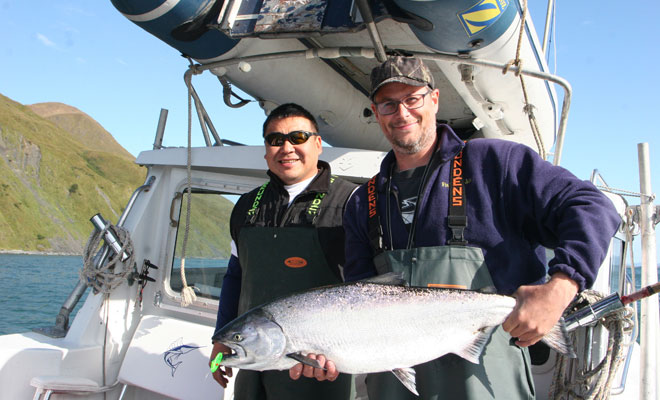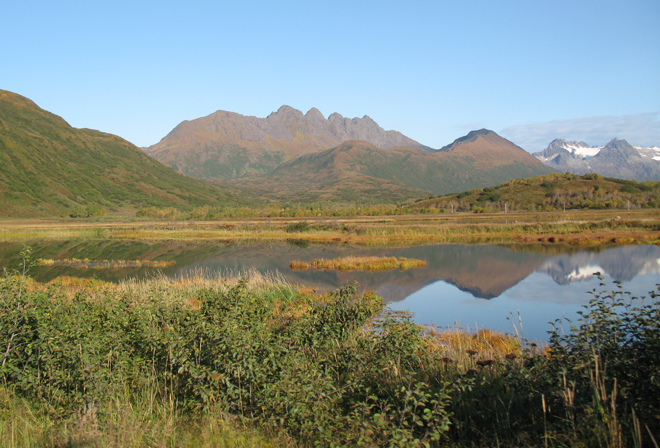
By Marcus Weiner
Fishing in Old Harbor, Alaska
There are still many wild places in Alaska where the waters teem with fish. Old Harbor, Kodiak, is surely one of them.
From salmon to halibut, cod to rockfish, these waters contain a saltwater bounty. The land and sea are Old Harbor’s grocery store, where the deer seemingly outnumber the people, goats dot the mountainside, and the variety and quantity of fish are dizzying. As an angler, it’s easy to fall in love with a place where king salmon can be caught all year.
The Native village of Old Harbor sits on Sitkalidak Strait in the southcentral portion of the island and resides on a corridor for traveling bait and feeding salmon. It’s home to some monster kings. Many of the Kodiak King Salmon Sportfishing Tournament-winning king salmon have been taken from Old Harbor. In addition, the deep waters and bottom structure are well suited for the whole array of bottomfish.

Jeff grew up fishing on his father’s boat and owned his own at 13. These years of fishing and hunting in the area have given him great insight into the movements and behaviors of the resident fish and game. It also makes a big difference that Jeff lives and fishes in Old Harbor year-round. He is a US Coast Guard licensed and insured captain, licensed big-game transporter and fishing guide,registered migratory bird guide and a former US Marine.
An outdoorsman in Old Harbor has the opportunity to fish for salmon, halibut, lingcod, and rockfish, and hunt for Sitka blacktail deer, mountain goats and sea ducks throughout the course of the year. April through July is the time to target large kings and halibut. Blacktail deer season opens August 1, making August and September a prime time for a combo of salmon, halibut and deer. October is the opener of duck season, and fishing is still excellent. Blacktail bucks are going into rut, so this makes it a good time to stalk a deer. In November, one can start to see ducks in the bays, and halibut and salmon are found there, too. It’s also a good time to find deer as they should be closer to sea level. Goats open on November 1 and deer hunting is in prime time, so in November, one can combine deer, goat, ducks and fish into one incredible trip. December and January are typically prime time for sea ducks and halibut and cod can be found in deeper waters.
I traveled to Old Harbor in late September this year with Fish Alaska operations manager Wayne Norris, and we are greeted with uncharacteristically great weather. High temperature hits 60, and there are few clouds in the sky and just a light breeze. Kodiak has challenging weather conditions, especially in the fall and winter, and this fine weather pattern bodes well for the activities to come. After stopping to acquire permits to hunt for deer on Sitkalidak Island from the Old Harbor Native Corporation, we depart the harbor to troll for king salmon. It’s a rare location in Alaska where one can dependably find kings in September, so I was excited for the possibility of coming tight to an ocean-bright Chinook.
After a short trip, we deploy the gear to a range of 18- to 30 feet. Two rods are rigged for trolling herring fixed with Luhr-Jensen Krippled Anchovie Helmets. Helmet colors include silver, green, red and clear. Twin hooks allow for one to pierce the body of the herring and one to sit just behind it. The front hook is pulled tight enough to produce a bend in the herring. This bend is crucial in getting the herring to roll properly so that it looks like a wounded fish to a king salmon on the hunt.
It’s not long before the first king is frantically peeling line. We can’t help but to hoot and holler. It breaches at about 100 yards and turns back on a mad dash to the boat. Luckily, it’s well-hooked and when the line comes tight again, I can feel the unmistakable pulse of a king salmon. Moments later a 30-pound hen hits the deck. We’ll later find out that this is one of two white kings that find their way into the box. The day continues with similar good fortune. All told we end up fighting four kings—a good half-day fishing by most standards, and extremely good considering it’s almost October. Most folks have long since stashed the stout rods and large landing nets in preparation for winter, and we’re out there loading the fish-hold with kings.
On day two, we’re going to climb one of the peaks on Sitkalidak Island and hunt for Sitka blacktail deer. Deer are abundant on Kodiak and there is an estimated 350,000 deer statewide. They are members of the mule deer family, with bucks averaging about 120 pounds and does about 80 pounds. Average lifespan is about 10 years and normal adult bucks display 6-point antlers.
The season opens August 1 to any buck, and changes to any deer on October 1. The plan is to take one buck and decide if there is time to take another. Each hunter is allowed two deer, but we’ll be satisfied with one between us. An average buck yields about 50 pounds of meat and we figure that the climb down from 1200 feet will be easier with one deer split between two.
In Unit 8 remote zone, which includes Old Harbor, the bag limit is 3 deer per person. The Old Harbor Native Corporation allows 2 deer to be taken on Sitkalidak Island, so while we were there, we could have taken two each on Sitkalidak Island and then one each on the Kodiak side of Old Harbor. One of the factors that contribute to the abundance of deer on Sitkalidak Island is that the Old Harbor Native Corporation limits the deer hunting transporters and guides to local residents.
At first light, we’re on the boat heading for the drop-off point. Scouting the mountain, we decide to climb up the face to a saddle that sits two-thirds of the way to the top. From there, we’ll glass the countryside for bucks.
Halfway to the point, several deer, including one buck, walk to the edge of the ridgeline and watch us. This encourages us to get into range, making the walk up the hill transpire quickly. Once at our designated glassing point, we realize that by reaching the ridgeline, it will open our sight to the surrounding area and in the process we may see the buck that spotted us earlier.
Cautiously approaching the ridgeline, we crawl the last 30 yards to the top. In seconds we’re looking at a nice buck at 300 yards. Several shots are fired and miss their target and by that time that the buck and his herd of does are out of sight. As you can imagine, we’re a bit bummed to have missed this early chance but elated to have had the opportunity at a buck early in the day.
Progressing forward to the crest of the next ridge allowed for about 270 degrees field-of-view of the surrounding country. We spot small herds of does and fawns, and finally spot the buck that had been narrowly missed. He’s positioned some 500 yards with the same four does.
It’s a long shot by my standards, but Wayne is ready for the task. He hits the buck and it’s clearly hurt and beds down away from the does. We hastily close the distance and Wayne dispatches the deer from 250 yards. By 11:30 a.m., we snap a few photos, take a moment to appreciate what’s happened and begin to dress the animal.
The main challenge with the hike off the mountain is that we chose to use a different route on the way down. It’s hard to tell if the route you are taking will dead-end in a ravine until you are right at the edge, and this is more difficult with 70 pounds on your back and a gun across your shoulder. Our route zigzagged down the mountainside, but in the end we successfully avoided ravines and dead-ends and had a reasonable 90-minute trek to sea level. We’ve traveled about five miles and went from sea level to 1200 feet and back. This is a great option for an unguided hunt, but make sure that you’ve spent some time getting in shape if you want to hunt deer when they are still on top of the mountains.
We spent the rest of the day working rock piles for bottomfish, and before sundown, eight species of bottom dwellers had come to the surface with a Luhr-Jensen Crippled Herring in their mouths. From the range of rockfish, to gray cod, halibut, greenling, flounder and the eventual Irish lord, it seemed that if it was down there, we’d see it attached to the jig. It was a day of hunting and fishing that I’ll not soon forget.
By day three, we’ve become a well-oiled fishing machine. Arrive at location, get the gear in the water, fight the fish to the boat, whack, bleed, ice and repeat. Limits of kings, halibut, rockfish, and cod found their way into the fish hold within a four-hour window. The bounty of the sea unfolds in front of us, and its rhythms resonate at a subconscious level.
As flocks of gulls work the water around balls of sandlance, one can envision the range of predators below doing the very same thing. In the distance, plumes of spray indicate breaching whales, no doubt in the area to feed on the wealth of species below. Bears roam the countryside, seeking the nutrients to sustain the long and cold winter. It seems that all of us are links in this food chain, shopping the many aisles of the Old Harbor grocery store.
Marcus Weiner is publisher of Fish Alaska magazine.
Finding Refuge on the Rock originally appeared in the December 2009 issue of Fish Alaska.


